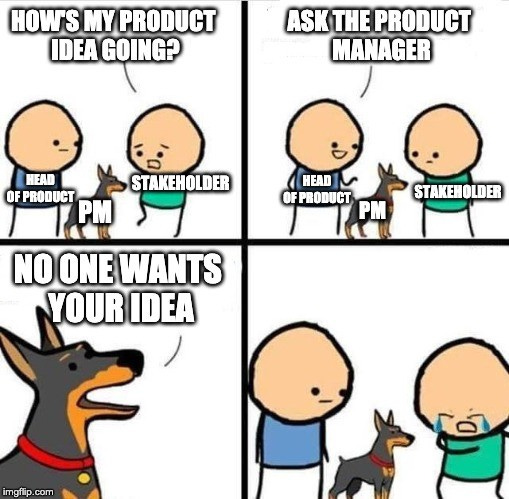Balancing is not something you find. It's something you create.
What are some ways you can create some balance in your stakeholder relationships?
Welcome! Product Party is a weekly (and sometimes twice a week) newsletter connecting product-minded people to ideas and content to stimulate conversation and help to solve real-world problems. All with a lil’ bit of fun sprinkled in. 🎉
It always happens. You’ve been working so hard on lining up the greatest backlog ever, and then…
One of your stakeholders tops in via e-mail with the old, “What will the lift be to do this?” What do you do? Do you flex those product muscles you always hear about - the ones that involve saying no? Do you use the classic “put it on the backlog” line?
With most of us, we don’t do either of these. We send a “yes, we’ll figure it out” and then do our best. We need to do these things at times to build trust and sometimes even to enable a runway to build what we want.
Knowing we’re still going to need to go back to your backlog with a possibility of saying why what you want your team to work on should trump random requests, here are a few ideas on how to start to adjust your thoughts to make stakeholder conversations a little easier.
Understand what your stakeholders want and show how your ideas will help achieve their goals.
Some organizations are aligned to a North star, making it easy for product people to tie their work to it. However, if you’re like many of your fellow product people, you may not have that organizational clarity cascaded throughout the ranks. This means you could be facing some scrutiny from stakeholders about what you are having the dev teams build. So what’s an excellent way to give yourself cover?
One of the answers is trust. It would be best if you built confidence with your stakeholders to give yourself some leeway to develop and launch these great ideas you worked so hard with your team to ideate. To build trust, it's best to invest time into understanding stakeholders' key values, metrics, and language. Frame ideas in a way that emphasizes how they can benefit stakeholders' goals and move the needle. If they can buy into the value and add you bring with your roadmap, even the most challenging stakeholder will start to come around and give you some support.
Reply quickly whenever stakeholder questions, feedback, and/or requests are asked.
I’m not suggesting you sit in front of your laptop until 1 AM every night, answering e-mails. However, a great way to build trust and runway with your stakeholders is to be ready to respond when a stakeholder has a question or feedback in a short time.
Realistically, you may not know the answer yet. You may need time to collect your thoughts and craft a response. You may even need to schedule some time to dig further into the nature of the questions/feedback. If you can at least acknowledge the stakeholder and set an expectation of when/how you’ll be able to answer that question, you recognize the importance of their communication which will go a long way.
Side note: I tried to summarize these ideas into an AI-generated image, and this one popped out. This is supposed to be your reaction to that late-night stakeholder email. Wowza.
Communicate more than you think is necessary.
One of the most important ways to ensure your stakeholders are aware of what is happening and the roadmap you are building is to communicate. Whether you meet regularly or are living in e-mail, there is a good chance your stakeholder group can easily forget your product goals unless you communicate with them consistently.
Having a great product that helps you quickly showcase your story (such as Roadmunk) makes spinning up communication easier, but it’s not a requirement. You can easily keep track of what’s happening high-level in whatever your favorite format is.
The most important thing here is to review your documentation regularly, keep it legible and bring it to any discussion with stakeholders. Additionally, create a cadence to reconnect with stakeholders and inform them of achievements and results.
Do you want to share any tips on stakeholder management with the Product Party? Leave a comment and let us know.
Listen to this
Q: What do you think is a realistic level of detail for a PM to provide their engineering team?
A: It’s all about balance. There needs to be a balance between how much information you need and what your cultural capacity is to meet the expectations of the information provided. Listen in to find out how to achieve that balance.
Learn from this
Other interesting stuff
Wonder Tools - This Substack is chock full of useful products emerging on the web.
Here are a few links to some of the things I’m checking out from them:
Create mobile tag clouds & word graphics: Tweetroot (free) | WordFoto ($2) | Phoetic ($1)
Make Timelines and StoryMaps: Beedocs 3d |TimelineJS (free) | | Storymap JS (free) | Juxtapose
Make a quick data gif: Google Data Gifmaker
Tools and Resources
Lean UX Canvas by Jeff Gothelff (PDF)
Official 5-Day Design Sprint by Jake Knapp and John Zeratsky (Miro)
Opportunity Solution Tree (Miro)
Support Product Party
Like what you’re reading? Tell some friends by clicking here and picking your favorite place to promote your favorite newsletters:







Excellent post about how to keep balance with your stakeholders! This a key relationship for product managers. I like the suggestion to focus on the product story for balancing requests.